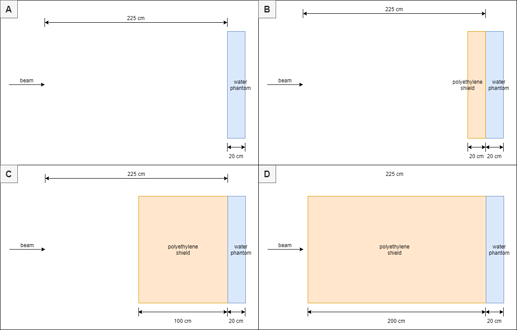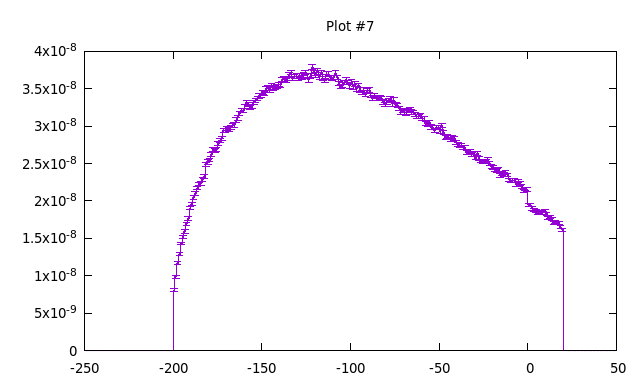Dear FLUKA experts,
I am using FLUKA/flair to assess the dose reduction of different material (composites). I am a beginner and for that reason start doing simple shield simulations to get acquainted with the software.
One of these simple simulations is to assess the dose reduction of a polyethylene shield with varying thickness and different particle beams at varying energies. Moreover:
- The thicknesses of the shield are 20 cm and (more extremely) 100 and 200 cm, this is just to see what kind of results are produced
- The DOSE and DOSEQLET of a water phantom directly behind the beam is used to calculate the dose reduction
- To calculate the dose reduction, one situation without a shield is simulated as well
- The distance between the radiation beam and water phantom for all situations is the same (i.e. 225 cm)
The four different situations are depicted below. Situation A: no shield, Situation B: 20 cm shield, Situation C: 100 cm shield, Situation D: 200 cm.
There are two matters I came across I wanted to discuss.
First, the resulting dose reductions from the DOSE USRBIN were quite unexpected for high energies. At 1 GeV for proton particles the dose reduction is:
- -21%, 1% and 54% (for 20 cm, 100 cm and 200 cm respectively)
At 10 GeV for proton particles the dose reduction is:
- -75%, -274% and -282% (for 20 cm, 100 cm and 200 cm respectively)
At 1 GeV for neutron particles the dose reduction is:
- -75%, -111% and -22% (for 20 cm, 100 cm and 200 cm respectively)
For 10 GeV protons and 1 GeV neutrons, the dose increased for all the thicknesses. I do assume secondary radiation takes part, but not in these large quantities that dose increases over 200% were attained. For this reason, I checked my Input settings to see whether some things were wrong but I did not come across such a thing. Because I’m a beginner, I wanted to ask you if you see anything extraordinary in my input settings. I have attached the inp and flair file herebelow for 10 GeV protons (when I simulate other shield thicknesses, the only changed variable is the Zmin for the RPP shield geometry. In the case of changing the energy and radiation, this is merely changing the ‘E’ and ‘Part’ of the BEAM card). If nothing seems extraordinary, do you maybe have another idea why these huge dose increases resulted?
sim4_1_GCR_pro_10GeV.flair (2.6 KB)
sim4_1_runsA.inp (2.0 KB)
Secondly, when I wanted to assess the DOSEQLET and DOSE for a 1 GeV Helium4 radiation beam in the case of no shield, I get the following error:
Ion beam above BME limit with no rQMD and no or incompatible IONSPLIT option! Execution terminated.
I checked some documentation online (e.g. Re: [fluka-discuss]: Ionsplit and rQMD from Paola Sala on 2020-07-18 (fluka discuss archive)) where it was mentioned that rQMD is used from 130 MeV/n up to 5 GeV/n. While the energy of 1 GeV is within this range, the error message still says there is no rQMD and no or incompatible IONSPLIT option. I am confused about what this exactly means now and why I got the error message. Do you know why this error occurred? I have included the related files herebelow.
sim7_0_GCR_He4_1GeV.flair (2.7 KB)
sim7_0_GCR_He4_1GeV.inp (2.0 KB)
sim7_0_runsA.inp (2.0 KB)
sim7_0_runsA.out (738 Bytes)
sim7_0_runsA001.err (258 Bytes)
sim7_0_runsA001.out (9.5 KB)
I hope I explained everything clearly, if not I can clarify further where necessary.
Many thanks in advance!
Kim



